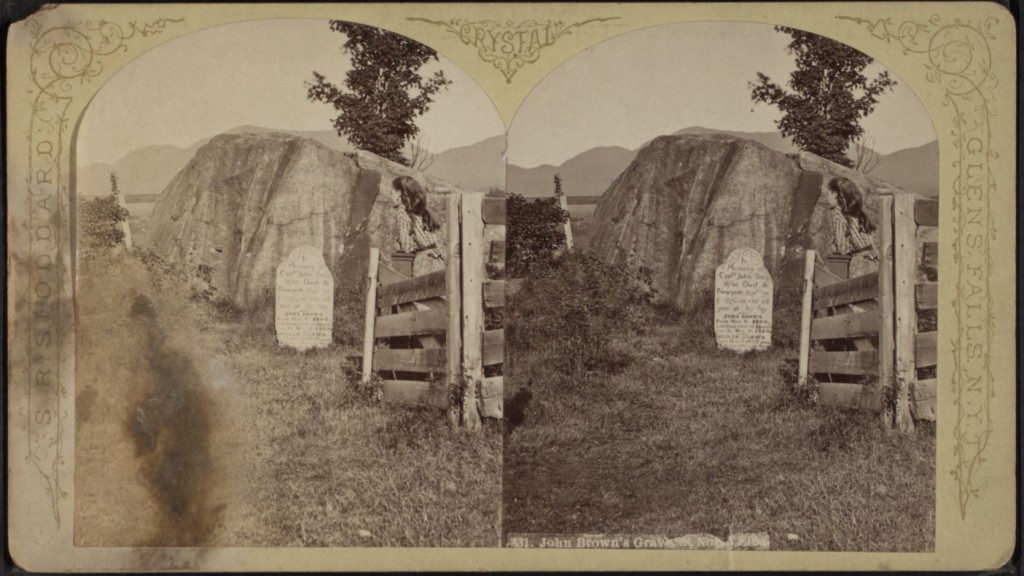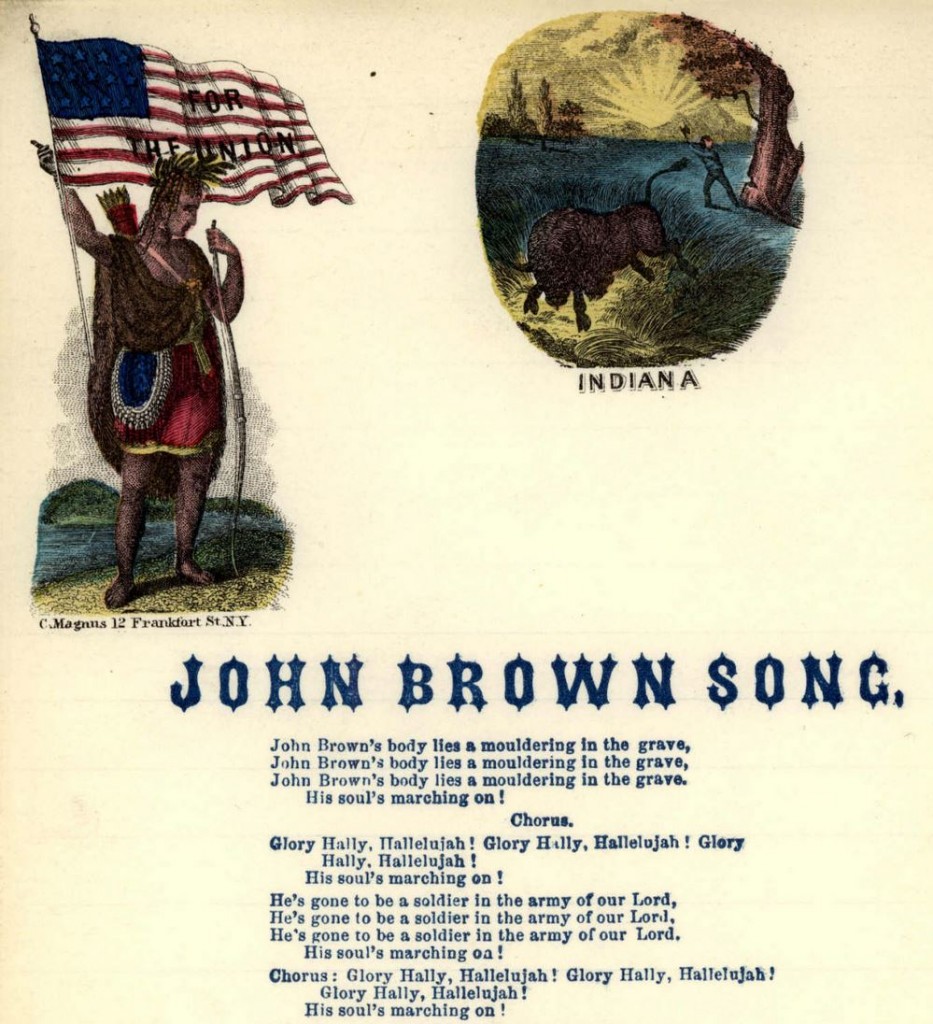Though you won’t become a millionaire panning for gold in Indiana, today’s recreational gold hunters have a lot of fun sloshing around Hoosier creeks in search of the shiny metal that led many a conquistador to his doom. Around 1900, however, Indiana farmers and geologists explored the possibility that the hills of Brown, Monroe, and Morgan counties might become something of a Klondike.
Mining for gold in the Eastern United States might sound far-fetched, but it goes back over two centuries. While Spanish explorers who crisscrossed parts of the South and Southwest were fooled by El Dorado myths, the soils of the Southeastern U.S. do hold significant quantities of the mineral. In fact, until the discovery of California’s huge deposits in the 1840s, most domestic gold came from North Carolina, home of America’s “first gold rush.”
The South’s gold industry began in 1799, when a 17-pound nugget turned up on the farm of John Reed, a former Hessian soldier. An undocumented immigrant, Johannes Ried had deserted from the British Army and settled near Charlotte after the war, anglicizing his name. Reed had apparently never seen gold and didn’t know what the shiny yellow rock his son had found was. For three years, he used it as a door post. Finally asking a jeweler to appraise it, Reed got swindled: he sold the big nugget, actually worth thousands of dollars, for just $3.50.

Fortunately, Reed and other North Carolina farmers soon caught on. By the 1830s, placer mines on farms around Charlotte gave way to heavy-duty mining operations. At their peak, these mines employed about 25,000 people. With deep-vein mines wreaking havoc on the land and destroying good agricultural sites, Southern gold mining may have played a role in the exodus of Southerners to fertile land in the Midwest. Yet the mines were a big boon for the U.S. government, which authorized a new branch of the U.S. Mint in Charlotte in 1837. Although it was still the poorest state in the South, North Carolina produced the first gold coins ever minted in the U.S. These replaced English and Spanish coins legally used by Americans as currency.
Begun by Germans, the Southern gold industry also attracted thousands of immigrants, mostly from places with a long history of mining, like Cornwall, Wales, and Germany. Many joined the rush to California in 1849, around the time the Carolina gold rush peaked. Others came to the Midwest, settling in places like Wisconsin, originally a federal lead mining district.
Gold mining never really took off in Brown County, Indiana. But when Southerners flocked into the uplands in the 1830s, they began finding gold there, too.
The irony is that one of the historically poorest Hoosier counties got an unexpected windfall from the glaciers that stopped on its doorstep and spared most of it from being flattened. That gift was Canadian gold, originally delivered to Earth — so the theory runs — by asteroid collisions four billion years ago.
While artist colonies found a different sort of gold in Brown County’s rustic hills, farmers — most of them with Southern Appalachian roots — found the allure of gold hidden in creek beds worth pursuing. By the 1920s, traditional upland farming practices, heavy logging, and hogs wandering loose through the woods had seriously degraded Brown County’s soil. The situation was so bad that by the time of the Great Depression, much of the county was nearly abandoned. Conservationists were able to snatch up plenty of cheap land for the new park, created in 1929, plus other degraded land later added to the Hoosier National Forest and Yellowwood State Forest. Though considered the crown jewel of the state park system today, Brown County was no wilderness a century ago. And the presence of gold there must have appealed to cash-strapped farmers eking out a basic livelihood.

Locals had been panning gold in streams like Bean Blossom Creek, Lick Creek, and Bear Creek since at least the 1840s, often turning up enough of the mineral to supplement their small income from crops and livestock. In 1897, one prospector told of making as much as $27 a day — over $700 in today’s money — but nobody here was getting filthy rich. Yet in 1903, Indiana State Geologist Willis S. Blatchley came down from Indianapolis to weigh in on an old debate about whether Brown County could sustain a serious gold mining operation.
Blatchley wrote several reports, intended for a popular audience. He described how the glaciers that once covered Indiana in ice five-hundred feet thick lugged gold-bearing rocks down from Hudson Bay, depositing them in “terminal moraines,” piles of rubble left where the ice sheets stopped. Water erosion then washed the gold out of the moraines into streams, dispersing it over several counties south of Indianapolis, where it turned up as tiny flakes in creek beds. Primitive panning and placer mines would help sift the gold out from mud and gravel, but more intensive mining to get all the gold wasn’t traditionally considered worth the effort.

Blatchley was one of Indiana’s great naturalists and took a strong interest in mining. Born in Connecticut, he grew up on farms in Putnam County, whose unusual geology and rich wildlife got him interested in nature, especially rocks, bugs, and butterflies. At Indiana University in the 1880’s, Blatchley studied with the great ichthyologist David Starr Jordan and geologist John Casper Branner. Pioneer Hoosier scientists, Jordan and Branner, later became the first and second presidents of Stanford University in California.
Ironically, Branner, who served as Arkansas State Geologist while still a faculty member at IU, was famously burned in effigy in 1888 after he exposed bogus gold and silver mines in the Ozarks, dashing the hopes of optimistic capitalists and investors there. One of Branner’s assistants on the Arkansas surveys turned out to be future U.S. president Herbert Hoover, who majored in geology at Stanford after Branner left his job in Bloomington to head the new department. (Hoover went on to get his first job after college as a gold-mining engineer in Western Australia and later worked for the Chinese Bureau of Mines and in Russia. Before he went into politics, Hoover was an internationally-recognized mining expert and even published a standard textbook on the subject. In 1912, he and his wife also made the definitive translation from Latin of a 16th-century German mining classic, De re metallica.)

On the heels of a new hunt for Hoosier gold, Branner’s former student W.S. Blatchley’s trip to southern Indiana in early 1902 was covered by the Indianapolis News. The News was excited to announce “great gold discoveries,” and the Chicago Tribune reprinted the story almost verbatim the following winter. The exciting gold finds of 1902, however, were on Highland Creek, between Martinsville and Brooklyn in Morgan County.
Leading the hunt for Highland Creek’s gold was a former California miner, F.F. Taylor, and R.L. Royse, an “Indianapolis gold and diamond prospector.” Taylor ran a hydraulic operation on the creek, called “The Black Eye Flumes,” a name inspired by all the ridicule heaped on Indiana gold mining. Though most experts remained skeptical, the flamboyant Royse announced his confidence that Indiana was soon destined to become the “richest placer gold state” in the Union.



Taylor and Royse tried to disprove what a previous State Geologist, John Collett, had said about Indiana gold. Collett, who died in 1899, quipped that he thought there was enough gold in Brown County to pay off the national debt, but that it would “take the dollar of gold mined and an extra dollar to mine every dollar of it.” The brash prospector R.L. Royse, however, insisted that not only was he going to make a fortune in Morgan County: soon enough, he said, he would come to downtown Indianapolis and “pan some gold out of Washington Street.” (He had already claimed to have found gold in a North Indianapolis street sewer.)
William E. Stafford, known as “Wild Bill,” was one of the colorful prospectors scouring the creeks of Morgan and Brown counties. The reporter for the News gave Stafford a long write-up in 1902. This “Hercules of the gold diggings” would reappear in the Chicago Tribune a year later.


Another man who panned gold on Hoosier streams was “Uncle” John Merriman. Merriman, who lived until 1906, was the son of Hoosier pioneer William Merriman. (William was born in Virginia in 1786, just three years after the end of the Revolutionary War.) Originally from Morgan County, John had lived around Ellettsville and Bloomington, then moved over to Fruitdale in Brown County in the 1870s, where he ran an orchard. Panning gold helped supplement his small income. In spite of a bad kidney ailment, Merriman took enough interest in gold to venture out to the California gold fields in the 1880s.
Like many men who went west, the Hoosier prospector never struck it rich. But in 1903, the 69-year-old helped show State Geologist Blatchley around Brown County’s own “gold fields.”


Blatchley wrote of men like John Merriman that some “do little else than pan gold along the streams.” The geologist did some panning himself on Bean Blossom Creek, where children went out looking for gold after floods and snow melts. Merriman came with him. Blatchley wrote that Merriman averaged about $1.25 a day — approximately $30 in today’s money. Both men thought that modern machinery could increase the yield.
Some panners, like W.W. Young — alias “Old Man” Young — sent their gold off to the U.S. Mint in Philadelphia. “Old Man” Young found fourteen ounces of gold in nine months of panning and got a receipt from the mint for $250.07, equivalent to about $7,000 today. Young was considered “quaint . . . the most peculiar character in any of the Indiana diggings. He will not permit anyone to be near him, and will not pan as long as there is anyone in sight.”

Blatchley’s report states that local Indiana “drift gold” averaged 22 carats, compared to 16-18 for California gold and 14-16 for Alaskan Klondike gold. In other words, Hoosier gold was actually superior to the stuff out West.
Yet he also recognized that shortage of local water sources during the summertime, when many streams ran almost dry, would seriously hamper mining of the mineral. “By constructing permanent dams in several of the valleys enough water could probably be conserved to tide over the dry season.” Taylor proposed sluicing water out of the White River, but the plan never really took on.
For a while, rumor even had it that birds had gotten interested in mining. Gold in duck craws? The tales you’re about to hear sound like an old St. Nicholas story. But for now, we’ll assume these aren’t just tall tales.

Ultimately, however, predictions about great yields of gold in southern Indiana weren’t justified. The slough of excited stories in the Indianapolis press about gold mining going on just “twenty-three miles from the golden dome of the Indiana State House” died out after 1903. But that didn’t stop two men from Ohio from coming to Brown County, panning the stuff, and buying a farm with their profits in 1908.
Today, gold prospecting is said to be the fastest-growing form of outdoor recreation of Indiana and many other states. (In 2010, when the price of gold hit almost $1,500 an ounce, the Wall Street Journal hosted a video about the revival of recreational gold-seeking in Vermont, where it’s a great way to get outdoors, but “more about the experience than the riches.”) Brown, Morgan, and Monroe counties are still the most popular places for gold prospecting in the Hoosier State, but Blatchley reported many other counties where the mineral turned up, including a few in northern Indiana like Cass and Warren.
But watch out, Indiana! Don’t hunt on private property unless you have permission first . . . even if you think you’re as clever as this guy:

Contact: staylor336 [AT] gmail.com



















